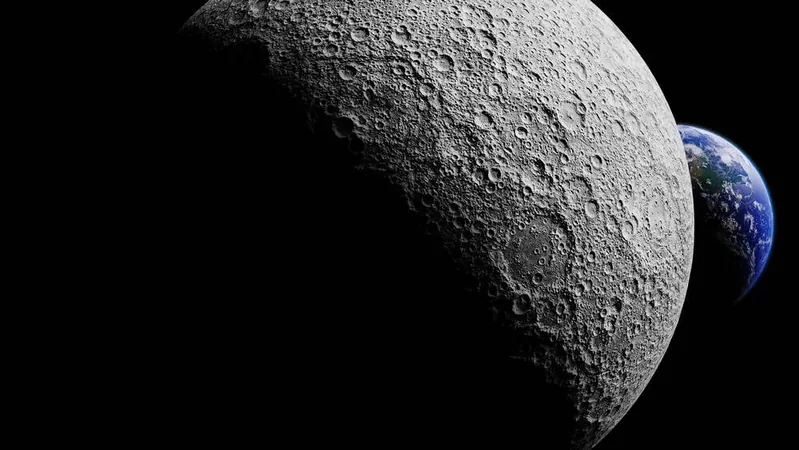
Quantum Breakthrough Brings Superfast Diamond-Infused Computer Chips Closer to Reality!
2025-01-03
Author: Daniel
Introduction
In an exciting leap for technology, scientists have made significant strides toward integrating diamonds into traditional silicon-based computer chips by leveraging quantum mechanics and reducing the temperature required for diamond growth in laboratory settings. This breakthrough paves the way for faster, more energy-efficient computing and complex electronics.
The Unique Properties of Diamonds
Diamonds are more than just a symbol of luxury; they hold incredible potential for electronics due to their unique crystal lattice structure. These properties allow diamonds to withstand high electrical voltages and dissipate heat effectively, making them ideal candidates for improving chip performance. However, the challenge has always been their production, as creating diamonds in the lab requires temperatures that exceed what silicon chips can endure during manufacturing processes. Traditionally, reducing the required heat would compromise the quality of the diamonds produced.
Research Findings
A study published on September 13 in *Diamond and Related Materials* revealed a solution to this conundrum. Researchers discovered a method to significantly lower the temperature needed to grow diamonds, allowing for their incorporation into standard silicon chip manufacturing procedures. Lead author Yuri Barsukov, a computational research associate at Princeton Plasma Physics Laboratory (PPPL), stated, "This could open a door for the silicon microelectronics industry."
Challenges of Diamond Synthesis
Historically, diamonds are synthesized through a technique called "plasma-enhanced chemical vapor deposition," where gaseous acetylene is deposited onto a solid surface. While acetylene is essential for diamond formation, it also tends to create soot, which obstructs the diamond's utility in high-tech applications such as chips, sensors, and optics. The research team unraveled the mystery of acetylene's dual behavior, identifying a "critical temperature" that determines whether acetylene contributes to diamond or soot formation. This threshold is influenced by acetylene concentration and the presence of hydrogen atoms near the diamond's surface, with hydrogen being crucial for facilitating diamond growth even at lower temperatures.
Exploring Quantum Applications
Beyond this diamond growth breakthrough, scientists are also investigating the unique properties of diamonds in quantum computing and secure communications. A study published on July 11 in *Advanced Materials Interfaces* focused on "quantum diamond" surfaces, specifically manipulating carbon atoms to create "nitrogen-vacancy centers." These centers are vital for quantum applications because they allow electrons in the diamond to operate under quantum physical principles, enabling the creation of qubits—fundamental units of quantum information.
The Promise of Qubits
Alastair Stacey, head of quantum materials and devices at PPPL, emphasized the transformative potential of qubits. "The advantage of qubits is that they can hold much more information than regular bits, giving us greater insights into their environment, making them extremely valuable as sensors," he explained.
Innovative Techniques in Hydrogenation
The research aims to establish a layer of hydrogen on diamond surfaces that would protect the nitrogen-vacancy centers while not disturbing the underlying structure. Traditional methods of adding hydrogen involve high temperatures, which are detrimental to the fragile nitrogen-vacancy centers. To address this, scientists are exploring two promising techniques: "forming gas annealing," which involves using a mixture of hydrogen molecules and nitrogen gas, and "cold plasma termination," which applies hydrogen plasma without overheating the diamond. While these methods are not yet perfect, they significantly reduce damage to the nitrogen-vacancy centers compared to conventional techniques and promise to enhance the functionality of hydrogenated diamond materials.
Conclusion
As these groundbreaking advancements unfold, the imminent integration of diamond into computing technology could revolutionize how we interact with electronics, paving the way for a new era of superfast, energy-efficient devices. Keep an eye out for this exciting development—digital transformation is just around the corner!



 Brasil (PT)
Brasil (PT)
 Canada (EN)
Canada (EN)
 Chile (ES)
Chile (ES)
 Česko (CS)
Česko (CS)
 대한민국 (KO)
대한민국 (KO)
 España (ES)
España (ES)
 France (FR)
France (FR)
 Hong Kong (EN)
Hong Kong (EN)
 Italia (IT)
Italia (IT)
 日本 (JA)
日本 (JA)
 Magyarország (HU)
Magyarország (HU)
 Norge (NO)
Norge (NO)
 Polska (PL)
Polska (PL)
 Schweiz (DE)
Schweiz (DE)
 Singapore (EN)
Singapore (EN)
 Sverige (SV)
Sverige (SV)
 Suomi (FI)
Suomi (FI)
 Türkiye (TR)
Türkiye (TR)
 الإمارات العربية المتحدة (AR)
الإمارات العربية المتحدة (AR)